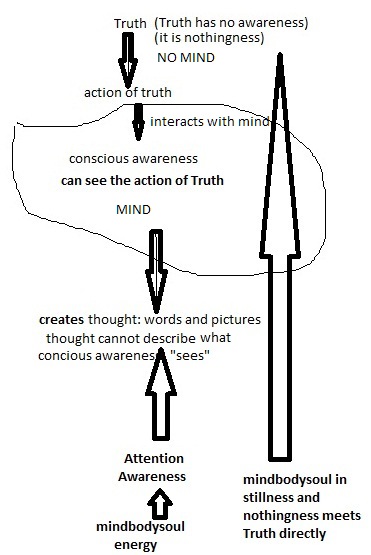“Brain’s “autopilot” mode lets you stop thinking” – New Scientist page 9.
OK, I can see why going to Mars is such a WoW thing or a car with a rocket on its back can break the speed of sound but really nothing beats this article in the New Scientist magazine this week about the fact that there are 2 modes of thinking. They have all the hallmarks of the teachings of Jiddu Krishnamurti, David Bohm and Rupert Sheldrake. All of Jiddu Krishnamurti’s reflections were experiential in nature. No test tubes in his lab but rather just him looking into his mind and following his thoughts. Soon the laboratories will be telling you this: a possible block diagram summary from a discussion between J. Krishnamurti and David Bohm.
One can differentiate between “speak thinking” where one silently has to speak what one is thinking to have to think at all and pictorial thinking in the “autopilot” mode. “Speak Thinking” is when one is spinning an observation in one’s mind and taking an observation further away from its original observation by turning it into a concept or idea in one’s mind. This concept or idea far away from the original observation can be seen as an illusion made from the mind. One can accept that a spun idea from the mind can be “new” too, far from its original observation, but not when it has all the elements of the past in you that went into making it. The Truly “new” comes from the repository of the Truth of things, not yet in mind or in an experiential past in you.
So there is “speak thinking” or just observation or pictorial thinking. Silence in mind comes from choosing one from the other. The technique of meditation plays on this difference – to shut down one for the other, by using a mantra as a distraction. But cross-legged meditation, I think takes it a step further and shuts down the mind altogether – both pictorial and “speak thinking” allowing you total silence. In a sense a kind of black out, while still living. Total silence and a kind of “where was I” when you slowly come out of it. I think, if true, understanding this, especially seeing how “speak thinking” works and bringing on more silence in the mind, while going about our daily activities, might just bring on the next generation of new thinking, truly new ideas, new way’s of living, new anything and everything as a kind of evolutionary process, that is not dependent on its past, to make the future and it is not an evolutionary process of matter anymore but rather one of the unseen intangible parts in you and of the mind. So what is truly “new” in one’s mind and how can you manifest it.
********************************************************
Brain’s ‘autopilot’ mode lets you stop thinking
EVER realised you’ve driven yourself home but haven’t really been paying attention? Brain scans have revealed that when your mind wanders, it switches into “autopilot” mode, enabling you to do tasks quickly, accurately and without conscious thought.
This autopilot mode seems to be run by a set of brain structures called the default mode network(DMN). It was discovered in the 1990s, when scans revealed that people show patterns of brain activity even when they aren’t really doing anything.
But what does the DMN do? Several studies have found that it seems to be involved in assessing past events and planning for the future. Others suggest the network is involved in self-awareness– although this has been called into question by findings that rats and newborns have a version of the DMN too.
It is unlikely that rats are conscious of themselves in the same way that humans are, says Deniz Vatansever at the University of York, UK. Instead, the DMN must have a more basic function, common to all animals.
Vatansever and his colleagues at the University of Cambridge wondered if the DMN might help us do things without paying much attention, such as tying shoelaces. To investigate, the researchers asked 28 volunteers to learn a card game while lying in an fMRI brain scanner.
In the game, each person received four cards. They were then given a fifth, and asked to match it to one of the four. But participants weren’t told the rules – whether to match the cards by colour or shape, for example. Through trial and error, each person figured it out after a few rounds.
As the participants began to play without thinking, their responses became faster and more accurate
While this happened, their brain activity resembled patterns that are typical of learning minds. But as the game continued, and participants knew how to match the cards without much thinking, their brain patterns resembled those of using the DMN – and their responses became both faster and more accurate (PNAS, doi.org/cfgp).
This suggests that when we “switch off”, our brains go into an autopilot mode that allows us to perform tasks reasonably without much thought.
This might also help explain why some tasks – such as playing a well-known tune on the piano – suddenly seem much more difficult when you go from doing them absent-mindedly to consciously thinking about them.
In people who performed best in the experiment, the various brain regions fired together more consistently, showing more coordinated activity. This suggests that the more strongly connected a person’s DMN is, the more effective their autopilot mode, says Vatansever.
It may be possible to train yourself to improve your autopilot mode. In other studies, people have been able to control their brain activity when shown real-time scans of their brains.
Similar “neurofeedback” training may enable people to boost their brain’s autopilot mode, allowing them to perform better on tasks without directly focusing on them, says Paul Stillman at Ohio State University.

